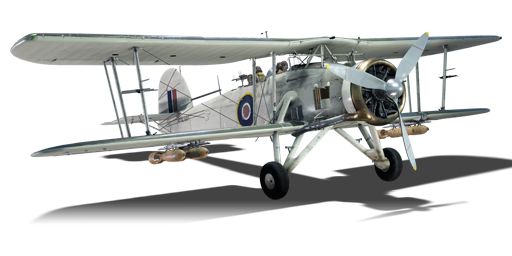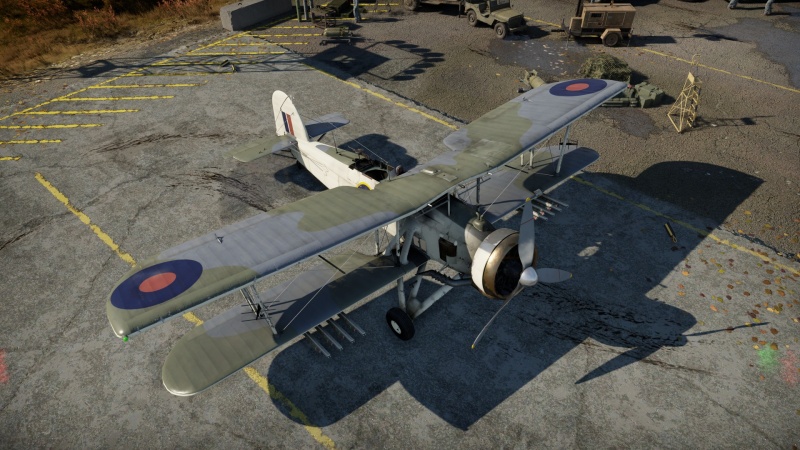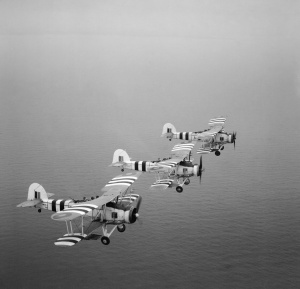Swordfish Mk II
| This page is about the gift British bomber Swordfish Mk II. For the regular version, see Swordfish Mk I. |
Contents
Description
The Swordfish Mk.II is the successor of the Swordfish Mk.I, the primary carrier-based torpedo bomber of the Royal Air Force. Despite being extremely obsolete by the outbreak of the Second World war, the Swordfish remained a crucial asset to the Fleet Air Arm. The Swordfish Mk II was developed as the second Swordfish iteration and was first introduced in 1943. It was fitted with a new, metal lower wing section, allowing it to carry rockets on underwing racks.[1] The Swordfish Mk II saw extensive service as a convoy escort, in the Atlantic and in the Arctic. During the course of the Second World War, the Swordfish distinguished itself as a highly reliable reconnaissance and torpedo bomber aircraft. It managed to sunk several German submarines and was used to harass Axis convoys.
It was introduced during Update 1.97 "Viking Fury" as a reward for the 2020 "Victory Day" event. The Swordfish Mk II can be helpful for inexperienced players who want to learn how to effectively destroy ground targets using bombs and unguided rockets. This is due to its low speed and excellent manoeuvrability, which make it easier for new players to aim and target ground units accurately. The Swordfish Mk II is an improved version of the Fairey Swordfish biplane torpedo bomber. It is equipped with eight underwing pylons that allow it to carry the AP Mk I rocket and the famous RP-3 rocket.
General info
Flight performance
While the Swordfish Mk II boasts a good stall speed, performing sharp turns will bleed your speed at an alarming rate. Under no circumstances should you attempt a steeply banked turn near the ground as you will lose a lot of altitude in the process. Instead, perform a shallow banked turn with the assistance of the rudder.
| Characteristics | Max Speed (km/h at 1,800 m) |
Max altitude (metres) |
Turn time (seconds) |
Rate of climb (metres/second) |
Take-off run (metres) | |||
|---|---|---|---|---|---|---|---|---|
| AB | RB | AB | RB | AB | RB | |||
| Stock | 247 | 240 | 5200 | 16.1 | 17.6 | 1.2 | 1.2 | 190 |
| Upgraded | 285 | 265 | 14.0 | 15.0 | 7.3 | 3.9 | ||
Details
| Features | ||||
|---|---|---|---|---|
| Combat flaps | Take-off flaps | Landing flaps | Air brakes | Arrestor gear |
| X | X | ✓ | X | ✓ |
| Limits | ||||||
|---|---|---|---|---|---|---|
| Wings (km/h) | Gear (km/h) | Flaps (km/h) | Max Static G | |||
| Combat | Take-off | Landing | + | - | ||
| 390 | 400 | N/A | N/A | 400 | ~6 | ~4 |
| Optimal velocities (km/h) | |||
|---|---|---|---|
| Ailerons | Rudder | Elevators | Radiator |
| < 200 | < 220 | < 260 | > 310 |
Survivability and armour
Examine the survivability of the aircraft. Note how vulnerable the structure is and how secure the pilot is, whether the fuel tanks are armoured, etc. Describe the armour, if there is any, and also mention the vulnerability of other critical aircraft systems.
Modifications and economy
Armaments
Offensive armament
The Swordfish Mk II is armed with:
- 1 x 7.7 mm Vickers E machine gun, nose-mounted (600 rpg)
Suspended armament
The Swordfish Mk II can be outfitted with the following ordnance:
- 4 x 250 lb G.P. Mk.IV bombs (1,000 lb total)
- 6 x 250 lb G.P. Mk.IV bombs (1,500 lb total)
- 2 x 500 lb G.P. Mk.IV bombs + 2 x 250 lb G.P. Mk.IV bombs (1,500 lb total)
- 1 x 450 mm 18 inch Mark XII torpedo
- 8 x AP Mk I rockets
- 8 x RP-3 rockets
Defensive armament
The Swordfish Mk II is defended by:
- 1 x 7.7 mm Vickers K machine gun, dorsal turret (600 rpg)
Usage in battles
This aircraft will ultimately be outperformed by any aircraft it faces, so its key strength is the payload. Most noticeably, the RP-3 rockets which can be fired independently of each other is sufficient to attack light pillboxes and light to medium tanks, even at higher tiers!
In air RB, try to avoid getting into air combat as your weaponry is insufficient. When it comes to defending yourself, you really don't have much of a choice. Your machine guns are inadequate and most players would shrug off your spray. The recommendation is to always have a teammate keeping an eye on you as you do your duties
In Ground RB, spawn only if you think that the enemy does not have anti-aircraft vehicles in battle since your slow speed makes it easy for the enemy to shoot you down!
In Naval battles, you should only engage naval targets when you think the target is distracted (for example, while they're attacking an allied ship).
Manual Engine Control
| MEC elements | ||||||
|---|---|---|---|---|---|---|
| Mixer | Pitch | Radiator | Supercharger | Turbocharger | ||
| Oil | Water | Type | ||||
| Not controllable | Not controllable Not auto controlled |
Not controllable Not auto controlled |
Not controllable Not auto controlled |
Combined | Not controllable 1 gear |
Not controllable |
Pros and cons
Pros:
- Allows the use of WEP, unlike the Mk I, as well as a larger oil cooler
- Very versatile with multiple payload options
- Excellent stall speed of 96 km/h
- Surprisingly good turning radius for a bomber
- Rockets can be fired off independently, starting on the left wing
Cons:
- Engine has less horsepower than the Mk I - very slow without WEP!
- Poorer climb rate than the Mk I
- Clumsier/bulkier than the Mk I
- Sharp turns bleeds speed at an alarming rate
- Inadequate defence weaponry
- Large minimum fuel load (>40 minutes)
History
The Swordfish is the second variant of the legendary Fairey Swordfish, the primary carrier-based torpedo bomber of the Royal Air Force. Despite being extremely obsolete by the outbreak of the Second World war, the Swordfish remained a crucial asset to the Fleet Air Arm. It was involved in many notable engagements, including the hunt for Bismarck and attack on Taranto. The Mk II variant was introduced in 1943, and featured the ability to mount rockets on underwing brackets.[1]
Design and development
The Fairey Swordfish was developed as an advanced variant of the earlier Fairey III, with the working name of TSR (Torpedo Spotting Reconnaissance) 1. The TSR-1 model was unsuccessful, and so a second TSR-2 model was developed - this model would eventually enter service as the actual Swordfish.[1] The aircraft first flew in 1934, and entered service with the Royal Navy in 1936. However, it was already obsolete by the time it entered service, due to its biplane design and slow speed. Despite this, the aircraft still entered service in large numbers.
The aircraft, being designed for operation on aircraft carrier decks, was equipped with folding wings.[1] It was powered by the Bristol Pegasus, a 9-cylinder radial that was state-of-the-art when the Swordfish entered service. Despite the powerful engine, the Swordfish could only reach 90 knots (166 km/h) unloaded.[1] The crew of three sat in an open cockpit that provided minimal protection against both flak and weather. The aircraft was armed with two rifle-calibre guns (one firing forward and one firing backwards), and could carry up to 1,500 lbs of bombs, mines, torpedoes or rockets.[1]
Operational history
The Swordfish, despite being extremely obsolete by the start of the Second World War, engaged in a multitude of conflicts. The aircraft played a key role in the Attack on Taranto in November of 1940, which crippled the Italian fleet and would later be used by the Japanese as a blueprint for Pearl Harbour.[1] Swordfishes were also responsible for crippling the battleship Bismarck, which was later sunk by British surface ships. During its time with the Fleet Air Arm, the Swordfish was affectionately nicknamed the 'Stringbag', a reference to the shopping bags used at the time; this referenced the Swordfish's ability to carry almost any ordnance that the FAA could fit on it.[1]
The Swordfish Mk II was developed as the second Swordfish iteration and was first introduced in 1943. It was fitted with a new, metal lower wing section, allowing it to carry rockets on underwing racks.[1] The Swordfish Mk II saw extensive service as a convoy escort, in the Atlantic and in the Arctic. During the course of the Second World War, the Swordfish distinguished itself as a highly reliable reconnaissance and torpedo bomber aircraft. The aircraft sank 21 submarines, numerous surface ships, and was responsible for the highest tonnage of Axis shipping destroyed by a single Allied aircraft type.[1] Several Swordfishes still exist today, including a flight-capable Swordfish Mk II operated by Navy Wings.[1]
Media
- Skins
See also
Links to the articles on the War Thunder Wiki that you think will be useful for the reader, for example:
- reference to the series of the aircraft;
- links to approximate analogues of other nations and research trees.
External links
References
- Citations
- Bibliography
- Navy Wings. (2020, November 05). Swordfish MkII LS326. Retrieved November 28, 2020, from https://navywings.org.uk/portfolio/swordfish-ls326/
| Fairey Aviation Company, Limited | |
|---|---|
| Fighters | Firefly F Mk I · Firefly FR Mk V |
| Bombers | Swordfish Mk I · Swordfish Mk II |
| Export | ◘Firefly F.Mk.IV |
| Britain bombers | |
|---|---|
| Torpedo | Swordfish Mk I · Swordfish Mk II · ▄Avenger Mk II |
| Dive | V-156-B1 |
| Hydroplanes | ▄Catalina Mk IIIa · Sunderland Mk IIIa · Sunderland Mk V |
| Light | Blenheim Mk IV · Beaufort Mk VIII · ▄Hudson Mk V · Brigand B 1 |
| Based on A20 | ▄Havoc Mk I · ▄Boston Mk I · ▄DB-7 |
| Hampden | Hampden Mk I · Hampden TB Mk I |
| Wellington | Wellington Mk Ic · Wellington Mk Ic/L · Wellington Mk III · Wellington Mk X |
| Halifax | Halifax B Mk IIIa |
| Stirling | Stirling B Mk I · Stirling B Mk III |
| Lancaster | Lancaster B Mk I · Lancaster B Mk III |
| Lincoln | Lincoln B Mk II |
| Shackleton | Shackleton MR.Mk.2 |
| Britain premium aircraft | |
|---|---|
| Fighters | Tuck's Gladiator Mk II · ▄Boomerang Mk I · ▄Boomerang Mk II · ▄D.520 |
| ▄Martlet Mk IV · ▄Corsair F Mk II · ▄Hellcat Mk II · ▄Thunderbolt Mk.1 · ▄Mustang Mk IA | |
| Hurricane Mk.I/L FAA M · Spitfire Mk.IIa Venture I · Spitfire F Mk IXc · Plagis' Spitfire LF Mk IXc · Spitfire F Mk XIVc · Prendergast's Spitfire FR Mk XIVe | |
| Typhoon Mk Ib · MB.5 | |
| Twin-engine fighters | Hornet Mk.I · Whirlwind P.9 |
| Jet fighters | Attacker FB.2 · Hunter FGA.9 · Lightning F.53 · Meteor F Mk.8 Reaper · Sea Vixen F.A.W. Mk.2 · F-4J(UK) Phantom II · ▄MiG-21 Bison |
| Strike aircraft | ▄Wirraway · Beaufighter Mk I (40-mm) · Wyvern S4 |
| Harrier GR.1 · Strikemaster Mk.88 | |
| Bombers | ▄Avenger Mk II · ▄Boston Mk I · ▄Catalina Mk IIIa · ▄DB-7 · ▄Havoc Mk I · ▄Hudson Mk V · Swordfish Mk II |






